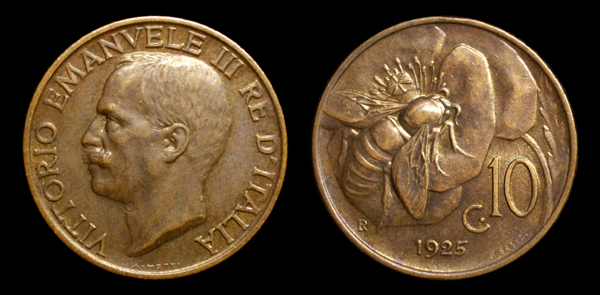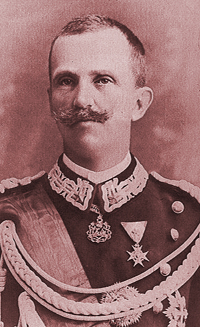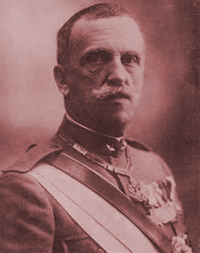
10 CENTESIMI COIN - ITALY - KING VITTORIO EMANUELE III - BEE
(KM 60)
Date: A.D. 1925
Obverse: Portrait head left - VITTORIO EMANUELE III RE D'ITALIA A. MOTTI
Reverse: Bee on a flower - 10 C.10 1925 R BROZZI
Engraver Obv: Attilio Silvio Motti
Engraver Rev: Renato Brozzi
|
Victor Emmanuel III (Vittorio Emanuele III) Was born in 1869 and was King of Italy from 1900 to 1946 and was briefly Emperor of Ethiopia (1936 - 1943) and King of Albania (1939 - 1943). He was the only child of King Umberto I and Princess Margrethe of Savoy, daughter of the duke of Genoa and he married princess Elena of Montenegro, daughter of Nicholas I, King of Montenegro. Together they had five children: 1. Yolanda Margherita Milena Elisabetta Romana Maria (1901-1986) Victor Emmanuel III of the house of Savoy reigned for 46 years and was the king of Italy through two world wars. Although early in his reign he was a an advocate for democracy and constitutional government. He soon discarded this view after his nations disastrous failures in World War I, the corrupt and disorganized war effort, the massive loss of life suffered by the Italian army, and the economic depression that followed the war. The economic depression had given rise to extremism among the heavily burdened working classes which in turn gave rise to Benito Mussolini which led to the fascists March on Rome. Although the King claimed that his armed forces could not have defended the city against the Fascist march, testimony from military leaders and surviving military records challenge his claim and seem to support the conclusion that after minor resistance, the King ordered his commanders to allow the Black Shirts to pass, an act that provoked the resignation of the Facta government. The King's failure to move against the Mussolini regime led to much criticism. Victor Emmanuel's decisions were possibly based on his belief that Fascism offered political stability and opposition to left-wing radicalism which appealed to many people in Italy at the time. For many reasons the King felt Mussolini and his regime offered an acceptable alternative to years of political chaos and was more appealing than the alternative: socialism and anarchism. Although he remained very popular all over the world for most of his reign, a succession of unpopular and poor decisions on his part caused him to lose favor rather quickly later in his reign. His assumption of the crown of Ethiopia was not universally seen as just. His public silence towards proposed racial purity laws endangered many of his Jewish subjects and those in the nation who actively sought to help Jewish refugees proved highly controversial. His alliance with Nazi Germany which dragged Italy into another prolonged war proved unpopular as well as the fact that he fled Rome in 1943 in the face of the advancing German army as others such as King George VI of England and Pope Pius XII refused to flee in the face danger. These acts among others caused him to fall from world favor as well as favor in his own nation and eventually proved fatal to the the future of the monarchy in Italy. After the war, In the face of growing resentment by the people, anti-royalist sentiment, and in an attempt to appease the people on the eve of a referendum on the future of the Italian monarchy, Victor Emmanuel III yielded most of his powers to his son in 1944 and eventually abdicated in 1946 taking refuge in Egypt where he died in 1947. He is buried in Alexandria. His abdication was bad timing and proved more harmful than good to the monarchists cause as it brought attention upon his own failings and diverted the peoples focus from the positive impression created by his son, Crown Prince Umberto, as the de facto monarch of Italy since 1943. At best, it was too little and too late. Upon his abdication his son became King Umberto II but in his brief month-long reign, he was unable to sufficiently alter negative public opinion of the monarchy. The monarchy formally ended on June 12, 1946 and Umberto II became a king in exile, leaving Italy to live in Switzerland and Portugal until his death 35 years later. the monarchy, through its association with Mussolini and fascism, had been fatally undermined. The 999-year reign of the Savoyards in various duchies and kingdoms, first in Northern Italy, then over the whole peninsula, had come to an end. |


